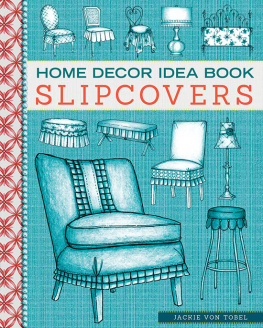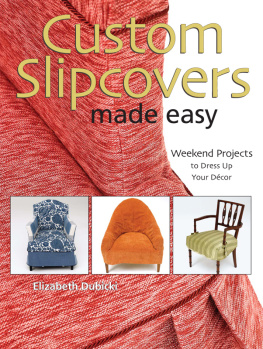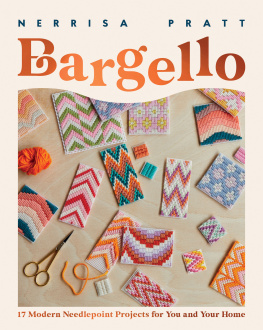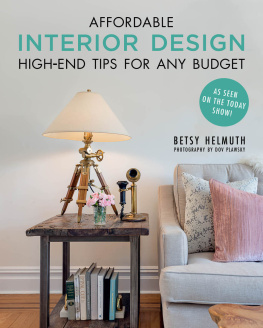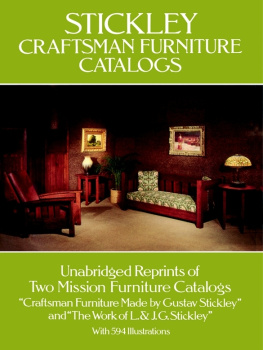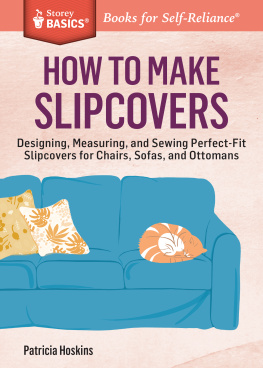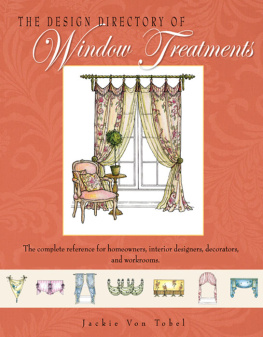Preface
My dear readers, writing and illustrating books on soft treatment design is a passion that I have been very fortunate to be able to follow over the past few years thanks to my publisher, Gibbs Smith, my marvelous editor, Madge Baird, and their team. This book is intended to provide design inspiration and basic knowledge to the reader. The designs shown within these pages are common, widely used standards within the interior design industry. The illustrations are my interpretation of those designs and of combinations of standard design elements used in the construction of slipcovers.
My goal is to produce a visual reference for soft treatment design that is a standard within the industry for the purpose of improving communication between the designer and the workroom as well as giving the designer a visual jump start as she prepares her original designs. This is a labor of love for me and is a testament to my passion for the industry that I have worked in for over twenty years.
All of the images and illustrations in this book are original and have not been reproduced from any other publication or product. Any resemblance to any other publication or product is coincidental and is derived as a result of the common, standard, and historical elements used to design and construct all slipcovers.
It has been a pleasure writing and illustrating this book and I hope that you find it inspirational and educational. Thank you for the tremendous support and acceptance you have given me over the past few years.
Sincerely,
Introduction
Nothing gives an old piece furniture a new lease on life like a beautiful slipcover. This book will provide you with the inspiration and knowledge necessary for you to make an informed decision about the style, design and construction of the slipcovers you want to sew or have sewn.
While this book does not contain step-by-step instructions on how to construct each design, it does discuss the key points of each cover and its basic design elements. Whether you choose to sew your covers yourself or use a professional workroom service, the information available in this book will assist you along the way.
For countless years, slipcovers were viewed primarily as a utilitarian product meant to provide a temporary fix for an old piece of furniture or a dust cover to prevent wear and tear. Remember your grandmothers clear vinyl chair covers? Todays slipcovers are an integral part of the design in modern interiors. They still serve a purpose but also provide flexibility and variety to an interior that traditional furnishings do not. Slipcovers are perhaps the single most impactful tool in the modern design arsenal.
My goal in writing this book is to provide a visual resource for design ideas. Many of the covers you will see in this book can be made at home by sewers who have a moderate to intermediate sewing capability. Others require the skilled expertise of a seasoned slipcover professional.
Home Design Idea Book: Slipcovers is an indispensable tool written to help you navigate the process of design. It contains hundreds of illustrations of creative ideas and common slipcover styles that can be made as shown or can inspire you to create unique designs of your own.
The information and techniques outlined in the first chapter will walk you through the many steps of slipcover design and construction:
Selecting Furniture
Not every piece of furniture is suitable for slip covering. Use the guidelines and checklist in the first chapter to determine if your furniture passes the test.
Selecting Fabric
Fabric selection is extremely important to produce a well-fitting and long-lasting slipcover. Follow the recommendations in this section to avoid costly mistakes.
Measuring Accurately
Fitting a slipcover is like tailoring a fine suit; the measurements must be precise and accurate. Learn simple ways to ensure a perfect fit.
Choosing an Appropriate Design
Use the basic design fundamentals and guidelines outlined here to choose the appropriate design for your specific piece of furniture.
Adding Embellishments
Small touches such as welting or trim can make a huge impact in your slipcover design. Choose from the individual embellishments in this book to personalize your design.
Whether you decide to sew your own or choose to rely on a professional to make your slipcovers, I hope you enjoy the process of choosing the right design for your piece of furniture.
Slipcover Basics
A Bit of History
The slipcover has a long and historic past beginning in medieval times where furniture was scarce and usually consisted of a hard stool or bench. Seat cushions made of rough fabrics were filled with straw and used to soften the hard seats of the well to do.
Slipcovers continued to be a luxury confined to the wealthy during the renaissance when furniture began to be upholstered in rich silk brocades and other pricy textiles. Plain slipcovers were used most of the time to protect this expensive fabric from wear and tear. They were removed only on special occasions when the owner chose to show off his finery to friends and guests.
During the seventeenth century furniture had become more readily available to the wealthy as well as other household luxuries and embellishments. The size of the homes of the rich had also increased substantially with many rooms used only on special occasions. This led to the creation of the dust cover; a loosely fitted white cover made from muslin or linen that covered all articles of value within a room when it was not in use. Furnishings at that time were true works of art and extremely expensive, they were meant to last for generations. The dust cover was a way for the owner to protect his valuables from the sun, insects, humidity, mold and mildew and other forms of wear and tear that would devalue his investments. Dust covers were made for chandeliers, wall sconces, mirrors, and anything else that could be covered.
As the eighteenth century began, more people had the means to acquire large homes and fine furnishings. In England it became popular to cover the heavy upholstery common in the day with bright cotton or linen tailored slipcovers for the summer season. These soft, lightweight fabrics were more comfortable on the skin in the warmer months and they served the practical purpose of absorbing moisture and protecting the expensive upholstery beneath. As time went by, the slipcover became an integral part of the design scheme, being constructed in fabrics that matched or coordinated with the interiors in which they were placed. This trend moved across the English channel to France where it was adopted enthusiastically by the design community, spawning a new industry of slipcover artisans to fill the demand.

